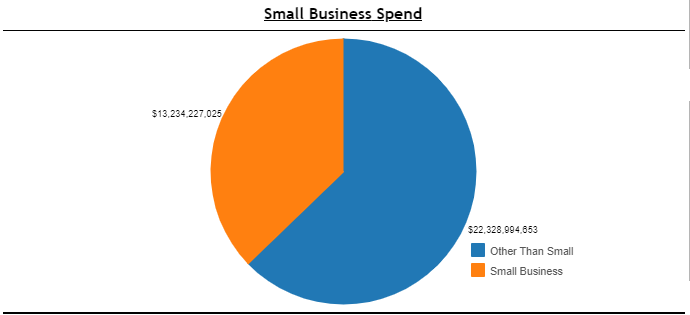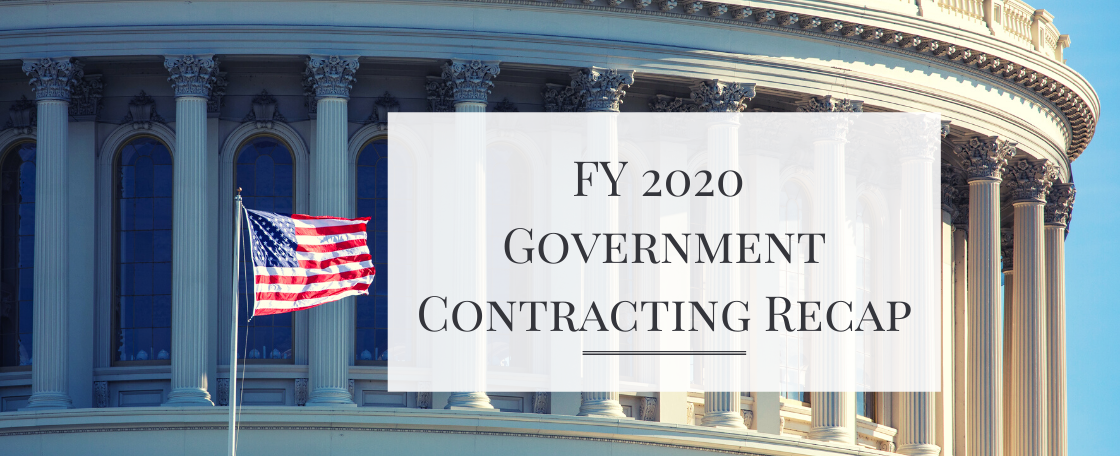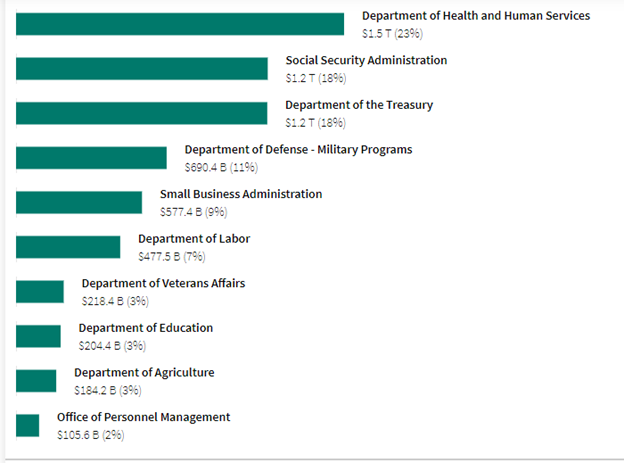Fiscal Year 2020 Government Contracting Recap
Government | Resources and Insight | 6 Min Read
If you look back at your 2020 plans and goals from last January, they probably don’t mention anything about a global pandemic. 2020 was an incredibly unpredictable year for all of us. Despite the economic uncertainty, government spending continues to steadily increase as agencies spring to action to make sure national, state, and local organizations have the resources they need to provide COVID-19 relief.
Although the government is in charge of mitigating disasters and emergencies, it relies on government contractors to acquire critical resources. As a government contractor, it’s important to examine the last Fiscal Year (FY) to see what the federal government was buying, which agencies were most active, and how much they were spending.
We put together a blog recapping FY 2020 which began October 1, 2019 and ended on September 30, 2020 with several different government spending and contracting statistics, so you can reflect on the past year.
Overall Government Spending
Even though the numbers below include all government spending and not just government contracting, it’s important to understand the whole picture.
In 2020, the federal government spent a record number of $6.5 trillion, far surpassing the record of $4.5 trillion spent last year.
The top 10 government agencies spenders were:
COVID-19 Government Spending
It’s no secret the Coronavirus pandemic was a large catalyst for the increase in government spending in FY 2020. Even though the full effect of the pandemic didn’t start to hit the U.S. until almost halfway through the government FY, it had a massive impact.
The federal government spent $1.62 trillion on COVID-19 in 2020 out of the $1.8 trillion obligated to be spent. COVID-19 spending accounted for about 25% of all government spending. As the pandemic continues, there is still currently $1 trillion allotted in the budget obligation for future relief (subject to change as the new COVID-19 bill is passed).
The top 5 COVID-19 federal government agency spenders were:
- The Department of Treasury ($958 billion)
- The Small Business Administration ($760 billion)
- The Department of Labor ($358 billion)
- The Department of Human and Health Services ($250 billion)
- The Department of Agriculture ($250 billion)
- The Department of Education ($57 billion)
Government Contracting Spending
Contractual Services and Supplies was the second highest line item in the U.S. federal government with a spending budget of $1.1 trillion.
The Department of Defense accounted for almost half of the contractual services and supplies with 46% of the spending. This is no surprise—for the past few years, the Department of Defense has outpaced civilian spending.
GSA Multiple Award Schedule (MAS) Spending
Government buyers spent over $35.4 billion in FY 2020 through the GSA Multiple Award Schedule (MAS) Program. Below is a further breakdown of the GSA MAS Program.
Top GSA MAS Industries
Here are the top 10 GSA MAS industries from FY 2020:
- IT ($16 billion)
- Professional Services ($8 billion)
- Industrial Products and Services ($2 billion)
- Transportation and Logistics Services ($1.3 billion)
- Office Management ($1.2 billion)
- Human Capital ($1.2 billion)
- Facilities and Construction ($941 million)
- Security and Protection ($548 million)
- Travel and Lodging ($547 million)
- Clothing, Textiles, and Subsistence ($315 million)
Top NAICS Codes through the GSA MAS Program
North American Industry Classification (NAICS) Codes are used to classify businesses for the purpose of collecting, analyzing, and publishing data related to the U.S. economy. Here are the top 5 NAICS Codes:
- 541519 - Other Computer Related Services ($6 billion)
- 541611 - Administrative Management and General Management Consulting Services ($4 billion)
- 541511 - Custom Computer Programming Services ($3 billion)
- 511210 - Software Publishers ($2 billion)
- 541330 - Engineering Services ($1.5 billion)
GSA MAS Small Business Spending

Of the $35.5 billion spent in the MAS Program, small businesses accounted for about 39%. Small businesses are an integral part of the MAS program. The federal government prioritizes their participation in government contracting, and as a result, there are several contracting assistance programs you might be eligible to join if you’re considered a small business. Here’s a breakdown of the 2020 spending by program:
- Women-Owned Small Business ($3.4 billion)
- Veteran-Owned Small Business ($3.1 billion)
- Service-Disabled Veteran-Owned Small Business ($2.2 billion)
- Economically Disadvantaged Women-Owned Small Business ($1.4 billion)
- HUBZone ($1 billion)
Upcoming Contracting Trends for 2021
Now that we have recapped 2020, it’s important to look ahead and see what 2021 could bring. Here are 3 contracting trends that could be prevalent in 2021:
Cybersecurity
Cybersecurity has always been a crucial component of being a government contractor, but the recent attacks on government agencies from expected Russian hackers and the increased number of remote workers has made it more important than ever. IT Cybersecurity is expected to grow 12 percent overall in 2021, and the Department of Defense has already begun to implement the Cybersecurity Maturity Model Certification (CMMC), new cybersecurity standards for contractors. It’s important you are aware of CMMC and all the cybersecurity requirements for government contractors.
5G Research and Development
You have probably heard of 5G in reference to your smartphone. 5G, which stands for 5th Generation wireless network technology, is the newest development designed to connect everything including machines, objects, and devices.
As 5G is being rolled out in select cities, the federal government is beginning to test its capabilities. The Department of Defense (DoD) is starting to research and test 5G technology on several military bases including smart warehouses and Virtual Reality (VR) for training purposes. They anticipate releasing a second round of solicitations in the spring of 2021.
Artificial Intelligence (AI)
Artificial Intelligence (AI) makes the government run more efficiently. While we still have a ways to go, the government has worked on certain principles to mitigate mistakes with AI and make sure the machines do not malfunction.
By now, we know the basics of building AI and its related technologies, so we are starting to see AI being implemented in several government projects including manufacturing robots, healthcare management, and urban development. Also, as government agencies are adapting to remote work, they have an increasing need for network efficiency and an adaptable IT infrastructure that is secure.
Looking Ahead for 2021
We obviously cannot predict exactly what is going to happen in 2021, but it’s clear government spending will increase as the pandemic continues and we distribute the vaccines. As a government contractor, it’s important to keep analyzing and researching government buying habits so you can target the right agencies.
We are also introducing a new president as Joe Biden enters the White House at the end of January. GSA plays a large role in the presidential transition, and as a result, government contractors have the opportunity to supply the new administration with the resources they need to make a smooth transition. With every new administration comes a shift in policy initiatives. You should keep an eye on what President-elect Biden will focus on, and what contracts your company can bid on.
If you want to learn more about how you can effectively sell your solutions to the government, check out our blogs “Everything You Need to Know About a Government Solicitation” and “Selling to the Government: 5 Tips to Increase Your Government Sales.”
For more government contracting resources, subscribe to our blog and newsletter, or one of our consultants would be happy to help you.








